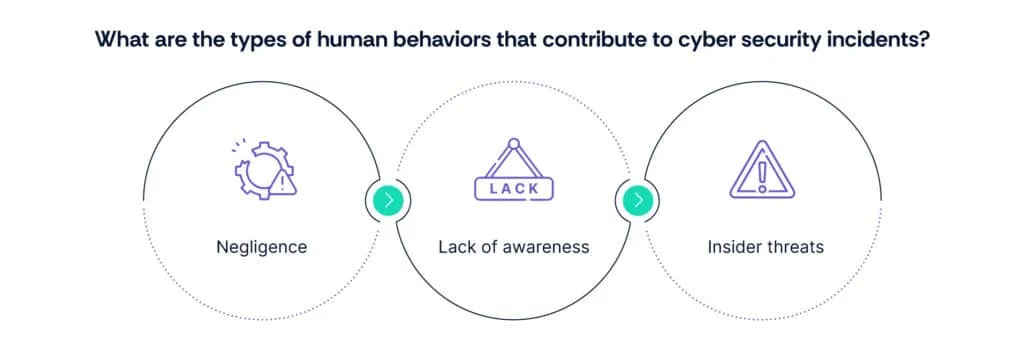Human Element: Defending Against Risks in Incident Response

Data breaches have become so commonplace in the world today that people are hardly alarmed by them. No one who uses the Internet can claim that their data is 100 percent safe, be it individuals, corporations, or governments. Some fresh-off-the-mill examples are cybersecurity incidents at the International Monetary Fund (IMF), the French government, and, ironically, the US Cybersecurity Agency. While there are many initial vectors, in 2023, humans were the initial vector in 74% of the breaches (Verizon).
Humans play a critical role not only in bringing about the incident but also in how and when an organization responds to such cybersecurity incidents. In this article, we will talk about the role of the human element in incident response.
What is the Human Risk Element in Incident Response?
Human risk in incident response refers to the vulnerability of individuals in an organization to either accidentally or deliberately cause security breaches or mishandle cybersecurity incidents. This includes factors like human error, lack of awareness, being prone to falling for social engineering tactics and posing insider threats.
Understanding Human Risk Factors
Humans are considered to be the weakest link in cybersecurity, making them susceptible to social engineering attacks and inadvertent errors. Neglecting the human factor can lead to significant financial losses, damage to reputation, and loss of customer trust. Therefore, it becomes a challenge for the leadership to understand and manage human behavior within an organization to prevent cyber incidents.
A. Types of human errors and behaviors contributing to incidents

1. Negligence
Negligence in cybersecurity refers to the failure of individuals to exercise reasonable care or attention when handling sensitive information or interacting with digital assets. This can include actions such as leaving passwords written down in easily accessible places, failing to install security updates promptly, or disregarding company policies regarding data handling.
2. Lack of awareness
A lack of awareness about cybersecurity risks and best practices can significantly contribute to incidents. Employees may inadvertently click on phishing emails, download malicious attachments, or share sensitive information with unauthorized parties due to a lack of understanding of cybersecurity threats.
3. Insider threats
Insider threats originate from individuals within an organization who misuse their authorized access to digital assets. These threats can be intentional, such as employees stealing sensitive data for personal gain, or unintentional, such as employees inadvertently sharing confidential information. Insider threats pose significant risks to organizations as they can exploit their insider status to bypass security measures and cause harm from within.
B. Impact of human error on incident response lifecycle

Human error significantly impacts the effectiveness of incident response in cybersecurity. Here’s how:
- Delayed Detection: Human errors, such as overlooking suspicious activities or misinterpreting alerts, can delay the detection of security incidents, allowing threats to persist and cause more damage.
- Inaccurate Analysis: Errors in analyzing the scope and severity of an incident can lead to ineffective containment and mitigation strategies. Misjudging the impact or misidentifying the root cause can prolong recovery efforts and exacerbate the consequences.
- Suboptimal Decision-making: Human errors in decision-making during incident response steps, such as choosing inappropriate response actions or failing to prioritize critical tasks, can hinder the resolution process and increase the likelihood of further breaches or disruptions.
- Escalation of Incidents: Errors in executing response procedures may inadvertently escalate incidents, causing additional harm to systems, data, and organizational reputation.
- Reduced Resilience: Cumulative human errors can undermine the resilience of incident response teams and processes, making organizations more vulnerable to future attacks.
Strategies for Managing Human Risk

Security and Exchange Control (SEC) has published the guidelines for cybersecurity management and incident response. It contains a detailed plan of what you should consider while formulating your incident response policy. Addressing human factors involves the following strategies.
A. Education and Training
1. Cybersecurity awareness programs
Conduct regular awareness programs to educate employees about potential cyber threats, common attack vectors, and best practices for safeguarding sensitive information. These programs can help raise awareness and promote a culture of security.
2. Training on incident response procedures
Provide comprehensive training sessions to ensure employees understand their roles and responsibilities during security incidents. Training should cover incident detection, reporting procedures, and appropriate response actions to minimize the impact of breaches.
B. Establishing Clear Policies and Procedures
1. Documented incident response plan
Develop and maintain a documented incident response plan outlining the steps to be followed in the event of a security incident. Ensure all employees are familiar with the plan and know how to access it when needed.
2. Guidelines for handling sensitive information
Define clear guidelines and protocols for handling sensitive data, including data classification, storage, transmission, and disposal. Emphasize the importance of data privacy and security to prevent unauthorized access or disclosure.
C. Implementing Technical Controls
1. Access controls and monitoring systems
Implement robust access controls to restrict access to sensitive systems and data based on user roles and permissions. Deploy monitoring systems to detect and alert on unusual or unauthorized activities, helping to identify potential security incidents.
2. User behavior analytics
Utilize user behavior analytics (UBA) tools to monitor and analyze user activities across networks and applications. UBA can help identify deviations from normal behavior patterns, enabling early detection of insider threats or malicious activities.
Building a Resilient Incident Response Team
Building a resilient incident response team is crucial for effectively managing and mitigating the security incident response process. Here’s how to create a strong team:

Conclusion
In today’s cybersecurity landscape, human error and behavior remain significant factors in incident response. Recent breaches at high-profile organizations underscore the pervasive nature of these risks.
To effectively manage human risk, organizations must prioritize education, training, and clear policies. By empowering employees with cybersecurity awareness and establishing robust incident response teams, they can better navigate threats and minimize the impact of breaches.
Addressing the human element is crucial for bolstering cyber defenses and ensuring resilience in the face of evolving threats. Through proactive measures and collaboration, we can work towards a safer digital future.
Ready to strengthen your organization’s risk management strategies? Scrut offers cutting-edge solutions to identify, assess, and mitigate risks effectively. Take control of your cybersecurity posture and safeguard your assets today. Contact us to learn more about our comprehensive risk management services.
FAQs
1. What is the human risk element in incident response?
The human risk element in incident response refers to the vulnerability of individuals within an organization to either accidentally or deliberately cause security breaches or mishandle cybersecurity incidents. This encompasses factors like human error, lack of awareness, susceptibility to social engineering tactics, and insider threats.
2. Why is understanding human risk factors important in cybersecurity?
Understanding human risk factors is crucial because humans are often considered the weakest link in cybersecurity. Neglecting the human element can lead to significant financial losses, damage to reputation, and loss of customer trust. By addressing human behaviors and vulnerabilities, organizations can better protect their assets and mitigate the impact of security incidents.
3. How can Scrut assist in managing human risk for incident response?
Scrut offers comprehensive risk management solutions tailored to identify, assess, and mitigate human risk factors in incident response. Through our advanced technologies and expertise, we help organizations strengthen their cybersecurity posture and minimize the impact of security incidents. Contact us to learn more about how Scrut can support your risk management efforts.


















